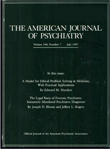Predictors and correlates of adaptation to conjugal bereavement
Abstract
The authors interviewed 162 widows 1, 6, 12, and 24 months after bereavement to determine which sociodemographic, prebereavement, and response variables and circumstances of the husband's death were related to distress level, as measured by the General Health Questionnaire (GHQ). The most important variable associated with high distress at 1 month was the woman's perception that she was seeing old friends less than before her husband's death. At 2 years it was possible to predict distress levels with 86% accuracy by means of a multiple regression analysis using 10 variables, including 1-month GHQ score, short final illness of the husband, and satisfaction with available help.
Access content
To read the fulltext, please use one of the options below to sign in or purchase access.- Personal login
- Institutional Login
- Sign in via OpenAthens
- Register for access
-
Please login/register if you wish to pair your device and check access availability.
Not a subscriber?
PsychiatryOnline subscription options offer access to the DSM-5 library, books, journals, CME, and patient resources. This all-in-one virtual library provides psychiatrists and mental health professionals with key resources for diagnosis, treatment, research, and professional development.
Need more help? PsychiatryOnline Customer Service may be reached by emailing [email protected] or by calling 800-368-5777 (in the U.S.) or 703-907-7322 (outside the U.S.).



